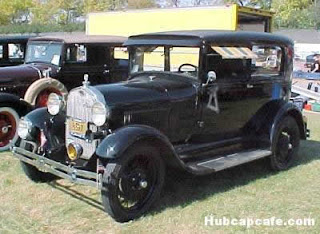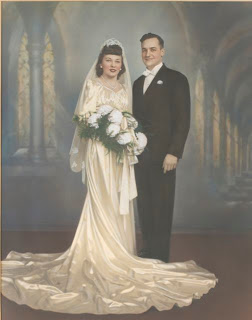
Model A Ford-1929 (See Blitzbuggy below)
credit: Hubcapcafe.com
It’s Carnival of Genealogy (CoG) again, the monthly opportunity for genealogy bloggers to ponder a specific topic—and for April it’s cars. Thanks to Jasia at Creative Gene for hosting CoG.
Blitzbuggy. For those of you who remember your World War II history, the term “Blitzkrieg” (Lightning warfare) may come to mind. Blitz means lightning in German, and knowing my dad, I’m sure irony came into play in naming this iconic automobile.
Blitzbuggy was my Dad’s family’s 1929 Model A Ford.
Blitzbuggy was special. My parents spoke and wrote about her as if she had a personality. She was maddening and endearing. She required pampering, cajoling, and endless tinkering, yet held her owners in thrall. My parents told stories about her breakdowns as if relating the escapades of a spoiled child, who, no matter how much trouble she caused, was unconditionally loved.
And like a loved relative, she was witness to major family events. When my dad wrote a poem to my mother for their tenth wedding anniversary, Blitzbuggy deserved special mention. I won’t quote the whole poem here—that’s better saved for a future post—but here’s the stanza in which Dad includes their faithful four-wheeled steed in his tribute to their decade-long marriage:

World War II: 1929 Model A Ford, “Blitzbuggy,” brings
son to Military Draft Board. Chicago, January 23, 1943
But Blitzbuggy would also be the conveyance for a beginning that was far less joyous than my parents’ wedding and one that I wouldn’t have known about until I found this out-of-focus photo tossed in among our collection. Coming upon it, I saw only an unremarkable old car parked on a snowy street, with no identifiable people. Until I turned the picture over, and read my father’s detailed notes on the back, I never would have known the critical event this photo documented.
Prior to finding this picture, Blitzbuggy had only existed in family lore. My father had probably told us what vintage the dear little car was, but it hadn’t stuck in my memory. Dad’s notes not only identified the car—its year, model, and make—but also recorded the contribution Blitzbuggy had made to one of the pivotal events of the 20th Century—and our family’s connection to it. But his identifying data weren’t just to jog his memory. They were a way of communicating important family history to my brothers and me. In the note, he refers to his mother as “Grandma,” even though she wouldn’t be a grandma for another three years. That means he wrote these details well after the picture was taken so his children would know its significance. Here are his exact words—in italics (my comments are in brackets. Parentheses are his):
January 23, 1943
Ebner’s drafting. Saying farewell. Grandma [Dad’s mother] in Blitzbuggy (1929 Model A Ford). Lil [my mother] on right side. [Only the back of her coat and hair are visible.]
In front of the Draft board
4748 W. Washington Blvd. Chicago, Ill
Frank Ebner, (ABE-ner) Gartz, born May 14, 1924, was my Dad’s ten-year-younger brother and my grandparents’ youngest son. His middle name was taken from my grandmother, Lisi’s, maiden name, one you’ve read in numerous past posts.
At eighteen years old, Frank was about to start his training to become a navigator for the Army Air Corps in World War II, and Blitzbuggy brought him to sign up for the service just a few blocks from the family home. It’s a familiar winter scene for the city: the snow is piled on the sidewalks, and typical Chicago greystone apartment buildings form a backdrop. The entire atmosphere of the photo—its blurry focus, the gloomy, colorless weather, the faces of the two women in the photo hidden or indiscernible, the lone black auto on a strangely empty street—create a visual metaphor for the emotions of a family about to send its youngest off to war.

Looks like a dismal day for a dismal event. I hope he made it back ok.
What a precious, evocative gift your father gave you – a wonderful illustration of Anna Quindlen’s quote at the top of your page.
as a car nut (it is in my genes) i really enjoyed this post. 🙂
Margel, The story of Uncle Ebner will unfold at some time in the future. Thanks, Candace and GSG. This was another one of those unexpected and “aha” moment finds that just keeps cropping up among the treasures.
I love your posts so I nominated you as one of my 15 favourite blogs. You can see more about it at my blog Family History across the Seas. However as the “requirement” to nominate another 15 bloggers is onerous I don’t expect you will necessarily want to do this. I just wanted to highlight your great site Pauleen
You’re a great writer and you have such fascinating family history stories to tell! The picture showing this memorable vehicle and telling it’s significance is a true treasure. I always look forward to reading your posts, Linda. Thanks for sharing and for participating in the COG!
SUCH a great story! I love the way your dad chronicals life. Looking forward to reading more about Uncle Ebner!
Thank you so much, Pauleen, for choosing my blog for the One Lovely Blog recognition! Check out Pauleen’s fine blog by clicking on its name in her comment: casmob. I’ll be dropping by your site often! Jasia, your road trip in that Monte Carlo took me back — just terrific. I encourage everyone to give it a gander at Creative Gene. So glad you enjoyed Blitzbuggy’s history. Courtney at Finding Kline is trying to solve the mystery of her grandparents, who died tragically and too young. Check it out.
What a spine tingling family find on the back of your photo. Thank goodness your Dad immortalized the day with his words….you have done him proud.
Whether I should admit it or not, I am just now playing “catch-up” on these blogs. It is actually quite fun to read them all at once. I loved seeing the photo of your mom and dad, as I remember your mom fondly – making chicken noodle soup for lunch on those many days I tagged along home with you for lunch, to be greeted by your mom and Buttons and Bows. I also enjoyed the story of your mom’s working at the Wrigley in the 40s. My mom also worked at the Wrigley, many years later – in the… Read more »